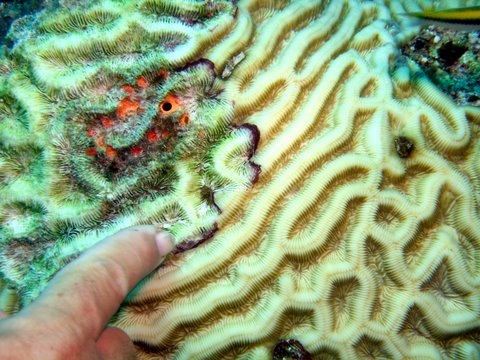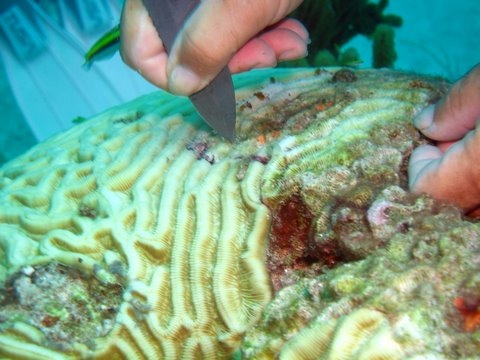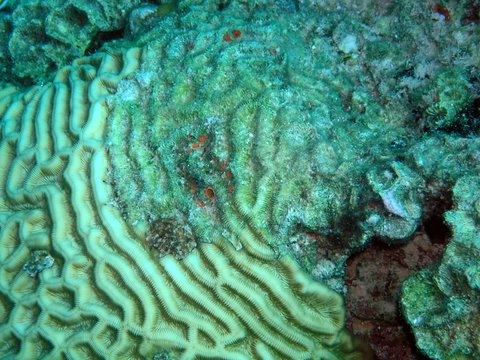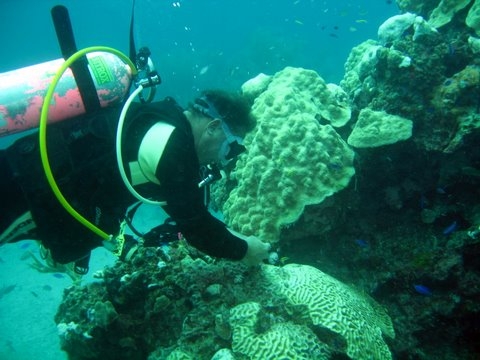From:TheBahamasWeekly.com
Black band disease
By Fred Riger
Apr 9, 2008 - 9:03:03 AM

A brain coral in bad shape, already weakened by several invaders, is
infected with Black Band Disease. Note the fuzzy dark band, leaving dead
white coral in its wake.
The orange patch is another problem coral faces, orange boring sponge.
Instead of growing up from the reef, boring sponge dissolves holes and
passages into the reef structure making a safe home for itself.
|
Black Band Disease has been a bane to coral reefs. It is a recent disease, but soon after it was first recorded, it was found to devastate coral over a wide area. Brain Coral is particularly susceptible, although many other species of stony coral can be afflicted.
The disease first presents as a fuzzy black spot that starts to enlarge. As it grows across the coral it leaves behind stark, dead white stone. The line of the Black Band can consume coral as fast as an inch a day. It is heartbreaking to see it infect old large coral colonies, some of which may be a thousand or more years old, and turn the living coral into dead rock in a week or two. If these coral heads were redwood trees, in full public\ view, the public would raise an outcry to save these heritage individuals. Most of the coral die a very private death, out of sight of all but a few
scuba divers.

A brain coral in bad shape, already weakened by several invaders, is
infected with Black Band Disease. Here I am cutting away the infected
tissue, being careful not to touch the living brain coral
|
For many years Black Band Disease was a total mystery. Where did it come from? How come no one noticed it before? What is it? And the all important question, how do you make it stop or go away?
Some of these questions have been answered.
Black Band Disease is not a single organism. It is a situation called a microbial mat. There are five different organisms forming this mat. All five are needed to infect coral. Three of the species are naturally occurring reef or sea species. Two are from human sewage. Separately none of these species harm coral, but when they get together something very interesting happens. While not all the interactions have been completely worked out, it goes something like this;

The brain coral in recovery. Treatment has successfully stopped and
eradicated the Black Band Disease from this coral head. The dead area will
not recover; it will provide a place for new and different reef organisms to
grow.
|
A cyanobacteria or blue-green algae, provides a lattice for other bacteria to live. A bacteria that take sulfur from seawater and turns it to sulfuric acid starts to live in the lattice. The sulfuric acid kills the coral. Other bacteria begin to digest the coral releasing nutrients into the lattice. Protein and sugar from the coral helps to feed the sulfur producing bacteria. After a few steps, from bacteria to bacteria, the complex proteins, fats and sugars from the coral are reduced to nitrate, phosphate and carbon dioxide which is used by the cyanobacteria to increase the lattice.
While Black Band disease is a widespread problem, specific local solutions are possible. Individual coral heads can be treated and the disease can often be stopped. The dead portions can never grow again, and will beinvaded by other reef organisms, some of which will break the coral head apart putting them on a path to turning these magnificent animals into common sand.
Scuba divers can remove the black band from infected coral. Many methods work, the best is an underwater vacuum to suck the mat off of the coral. Since it is unlikely a scuba diver will be carrying an underwater vacuum, the next best method is to carefully cut the mat away from the healthy coral and wave a pulse of water over it to lift the mat away from the coral. It really doesn't matter if you cut into a bit of the healthy tissue, at the speed Black Band Disease travels; you are still doing the coral a favor. Treatment has to be repeated at weeklong intervals to make sure the band
doesn't start over.

Here is the author spreading antibiotic cream on the area of the coral head
newly cleaned of Black Band Disease. Care must be taken not to touch
healthy areas of the coral reef.
|
Black Band Disease is very susceptible to antibiotics. While it is very hard to do, spreading a thin layer of triple antibiotic cream on the newly cleaned edge will greatly increase the chances of stopping the disease.
In the long term, the best way to fight this disease is to find a way to stop putting sewage in places where it will end up at the reef.
About the Author: Fred Riger is president of the Grand Bahama Dive Association. Fred operates Grand Bahama Scuba, and has lived in The Bahamas for 25 years. He can be contacted at
fred@grandbahamascuba.com
© Copyright 2008 by thebahamasweekly.com -